Tiny Chef – Mobile App Case Study
The Product:
Tiny Chef Adventures is an imaginative project designed to showcase my capabilities in creating engaging and educational digital experiences for children. This conceptual platform, developed as part of my Google UX Design Professional Certificate, introduces young learners to the joys of cooking through a fun and interactive approach.
My Role:
As the UX designer, I led the design process from concept to completion, focusing on crafting an interface that is intuitive and appealing to children. My responsibilities included developing interactive cooking lessons, designing user-friendly navigation, and integrating gamified elements to maintain engagement and make learning enjoyable.
The Goal:
The aim of Tiny Chef Adventures is to foster a love for cooking while educating children about healthy eating habits. This fictional project demonstrates my ability to design a comprehensive user experience that captivates and educates its audience, reflecting my skills in UX design and interactive media.
Tools:
Figma, Photoshop, Illustrator.
Disclaimer:
All names, images, and content presented here are fictional, created solely for the purpose of showcasing my design capabilities in Figma, with the assistance of AI. Sugar Bliss Bakery, along with any referenced personas, locations, or services, is entirely imaginary and intended for demonstration purposes only.
The problem
Tiny Chef effectively addresses a gap in educational platforms for young children interested in learning to cook. Not only does it cater to beginners in their culinary journey, but it also offers guidance from real chefs and dietary experts. This approach ensures a comprehensive learning experience. However, existing apps often lack this level of expert interaction or fail to make the experience engaging for young audiences. Consequently, children and their parents are left without a reliable way to incorporate professional culinary skills and nutritional education in a way that is both accessible and captivating.
The goal
The primary goal of Tiny Chef is to create a user-centered mobile app that seamlessly incorporates professional chefs and dietitians into cooking lessons, making learning both fun and credible. The app will feature intuitive navigation, vibrant visuals, and interactive, step-by-step cooking lessons led by experts. Furthermore, it enhances user engagement through gamification with challenges and rewards, which makes culinary education a truly rewarding experience. Ultimately, the objective is to provide a platform that not only entertains but also educates children in proper culinary techniques and healthy eating habits, fostering a well-rounded appreciation for cooking.
Design process
User Research and Insights Gathering
To kick off the Tiny Chef project, I conducted comprehensive research to understand the current market for children’s cooking apps. Although there were several existing options, none fully met the needs for a genuinely interactive, accessible, and educational platform designed specifically for young chefs. Unlike other apps, Tiny Chef fills this gap by combining engaging learning experiences with practical cooking skills in a safe, voice-assisted, and allergy-aware environment. This unique concept centers around making cooking accessible to all children, especially non-readers, with features like bold visual categories, voice-guided recipes, and challenge levels that adapt to their abilities.
Defining User Personas and Journey Mapping
With a clear market gap identified, I developed detailed user personas for Tiny Chef, representing young users who would benefit most from a structured cooking app. These personas helped shape every element of the app’s design, focusing on the unique needs of children, such as visual search categories for non-readers and safe, age-appropriate recipe suggestions. Journey mapping for each persona clarified essential touchpoints – such as allergy selection, interactive recipes, and motivational rewards—to ensure the app aligns with each user’s learning and engagement journey, fostering a fun and educational experience.
Sketching and Wireframing
The design process started with initial sketches to outline the app’s primary interfaces, emphasizing intuitive navigation and accessibility. These sketches evolved into wireframes in Figma, which established a user-friendly flow that allows kids to easily browse and engage with recipes, games, and educational content without needing advanced reading skills.
Prototyping
In the high-fidelity prototyping phase, I introduced bright visuals, gamified interactions, and Tiny Chef’s unique color-coded difficulty system, where green, orange, and red indicators help children select recipes that suit their skill level. Features like “Healthy Eating Tips” and interactive cooking challenges were refined here to make learning fun, while a voice-guided option was added to read recipe instructions aloud, ensuring inclusivity for all children.
Final Design and Developer Handoff
The final design involved polishing prototypes and preparing thorough specifications for development, including a detailed style guide, color palette, and typographic hierarchy. Throughout this phase, I collaborated closely with the development team to ensure the app’s features—such as personalized recipe recommendations and parental controls—were implemented accurately. This detailed handoff provided all assets and required guidance, supporting a seamless transition from design to a fully functional, engaging cooking app for kids.

Persona Summary: Lily McAllister
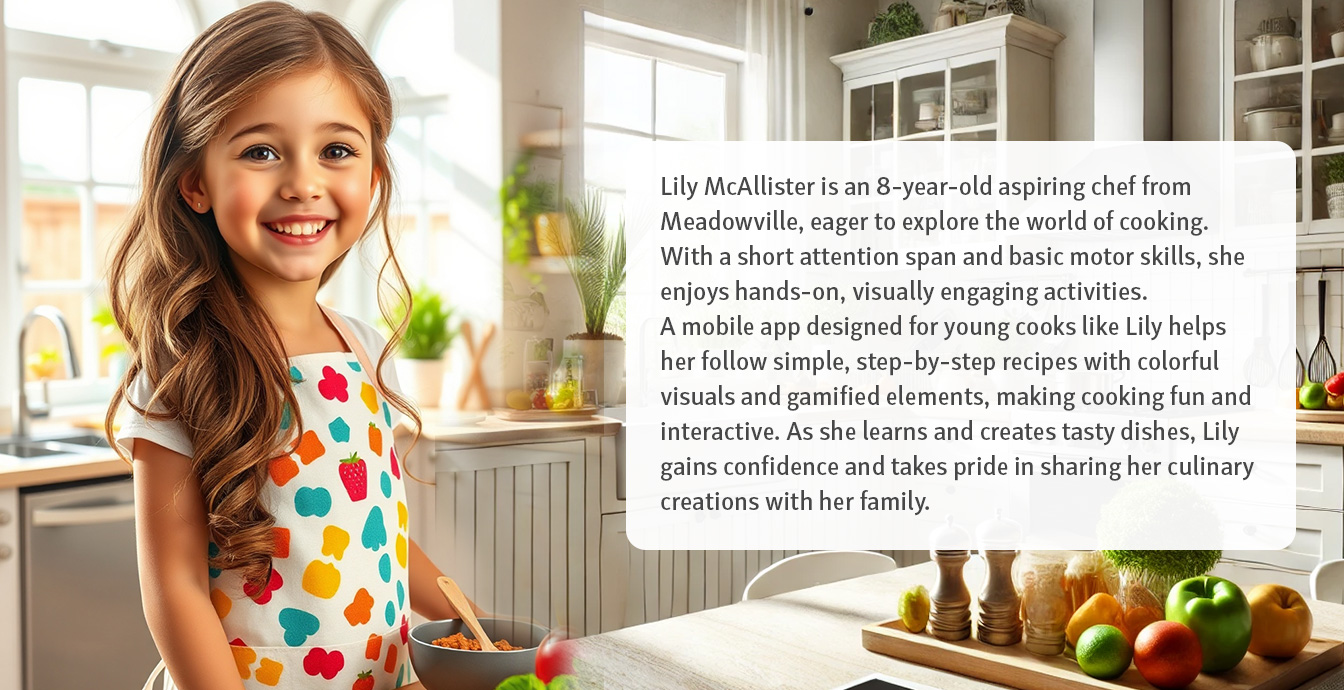
Understanding the User
Lily McAllister, an 8-year-old aspiring chef from Meadowville, is eager to explore cooking but has a short attention span and basic motor skills. She enjoys hands-on, visually engaging activities. A mobile app designed for young learners helps her follow simple recipes with large visuals and step-by-step guidance, using gamified elements to keep her interested. As she creates dishes, Lily builds confidence and takes pride in sharing her creations with her family.
Persona Summary: Jordan Lewis
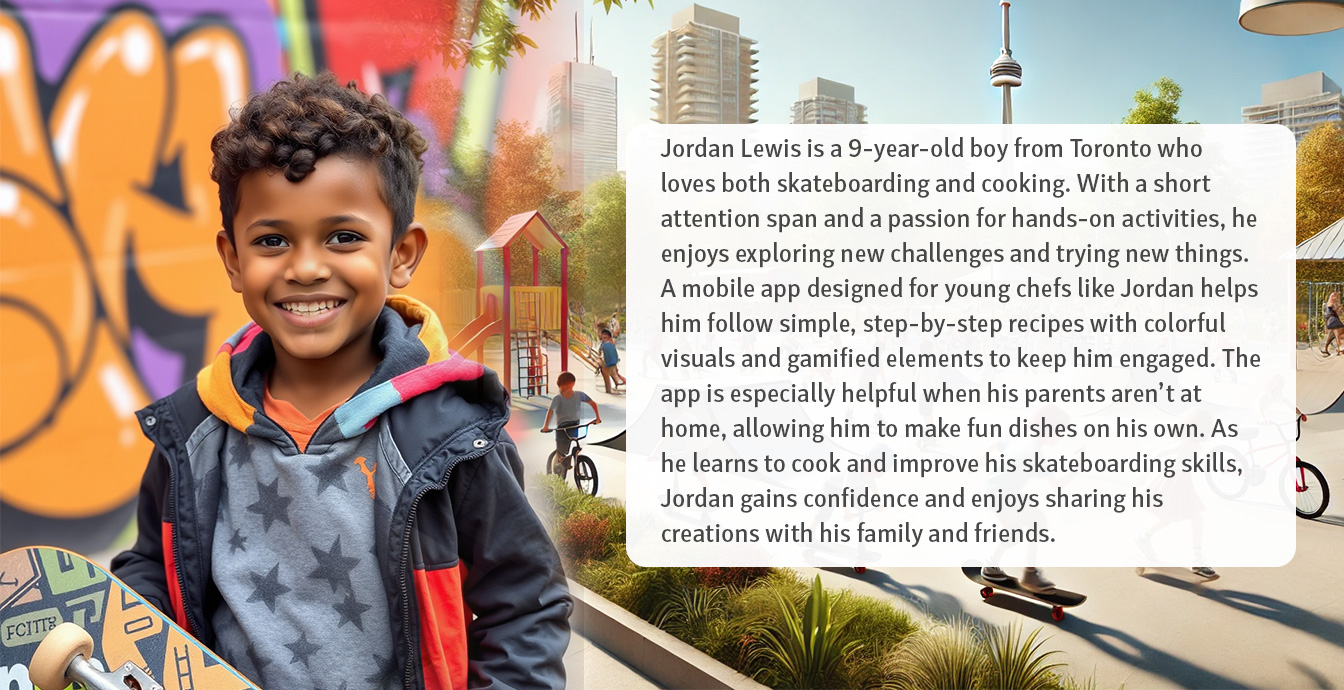
Understanding the User
Jordan Lewis is an energetic 9-year-old with a strong interest in both skateboarding and cooking. He enjoys hands-on activities and needs an environment that provides engaging, interactive experiences. With a short attention span, Jordan thrives on fun, visually appealing tasks that hold his interest. When his parents are away, he enjoys using a mobile app that allows him to follow simple cooking instructions and create dishes independently. The app needs to be easy to navigate with colorful visuals, step-by-step guidance, and gamified elements to keep him motivated. As Jordan continues to explore his passions, he seeks confidence-building activities that allow him to express creativity, whether it’s through cooking or skateboarding.
User Journey Map
The journey map for the Tiny Chef app demonstrates how it caters to the needs of both kids and parents. From exploring fun and healthy categories like “Creative Treats” and “Fun Bites” to providing a voice-assisted search for little chefs who can’t yet read, the app transforms cooking into a delightful adventure. Additionally, Tiny Chef supports busy parents with easy, personalized options, while kids get to experiment with colorful recipes and create their own masterpieces. This intuitive, engaging flow not only sparks creativity but also ensures a hassle-free cooking experience, making family mealtime both educational and enjoyable. Ultimately, Tiny Chef empowers young cooks to express themselves in the kitchen, while parents benefit from simplified meal planning and happy little chefs.
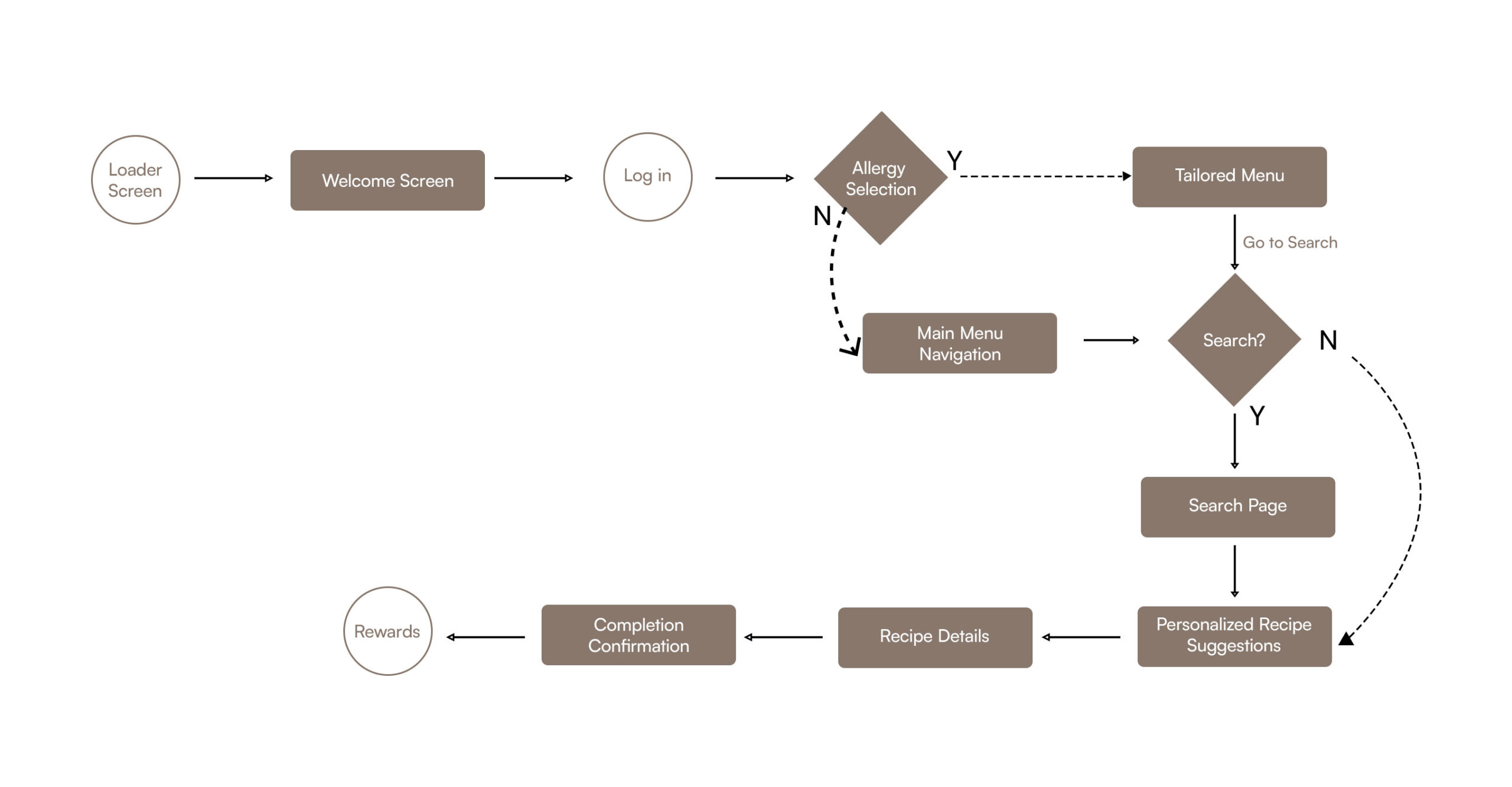
Key Features
Interactive and Age-Appropriate Recipes: Tiny Chef offers a visually engaging recipe library sorted by age group and dietary needs, featuring fun categories like “Creative Treats” and “Fun Bites.” Each recipe includes colorful visuals and easy-to-follow instructions that make cooking accessible for kids, promoting confidence in the kitchen.
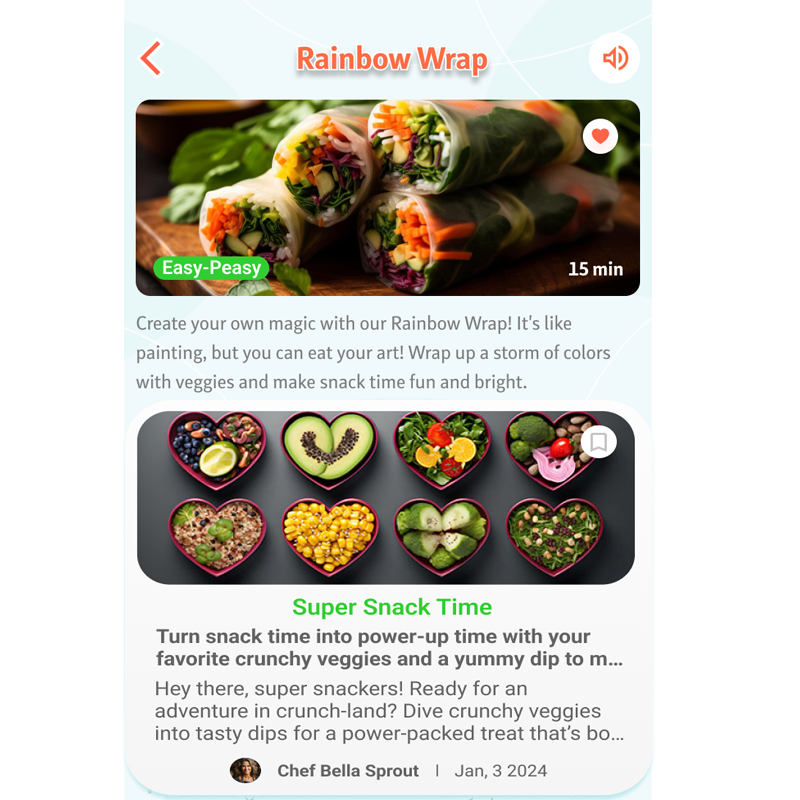
Interactive Cooking with Healthy Eating Tips: To make cooking enjoyable and educational, Tiny Chef includes interactive step-by-step instructions alongside video tutorials. The “Healthy Eating Tips” feature provides helpful guidance throughout, encouraging kids to engage with recipes while learning about nutritious choices.
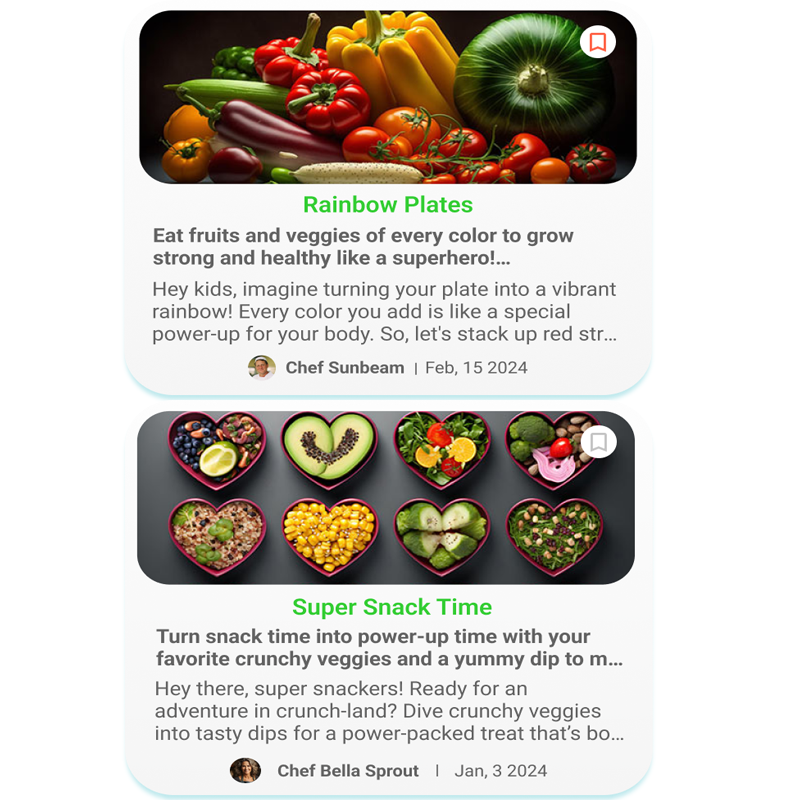
Allergy-Sensitive Recipe Filtering: Understanding the importance of dietary restrictions, Tiny Chef allows families to filter recipes by allergy and dietary preferences, including substitutions for safe ingredients. This feature ensures inclusivity, making cooking accessible and safe for children with specific dietary needs.
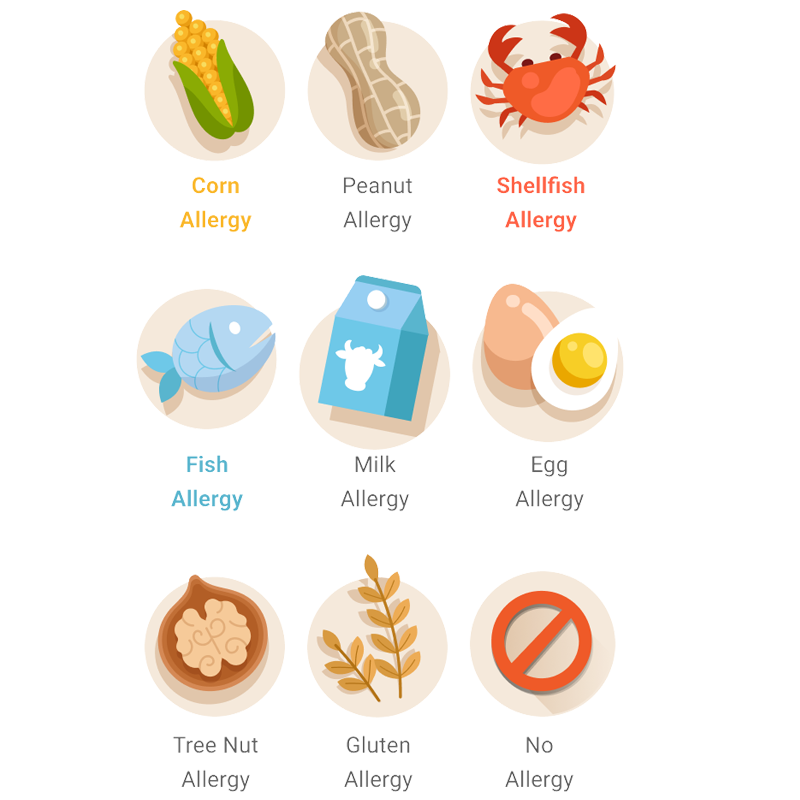
Gamified Rewards System with Voting: The app features a fun, motivational reward system where kids can earn badges, unlock achievements, and participate in cooking challenges. When kids share their completed recipes, others can vote on their creations, adding an interactive and social element to the experience. This gamified approach keeps kids engaged, providing positive reinforcement and a sense of accomplishment with each culinary task completed..
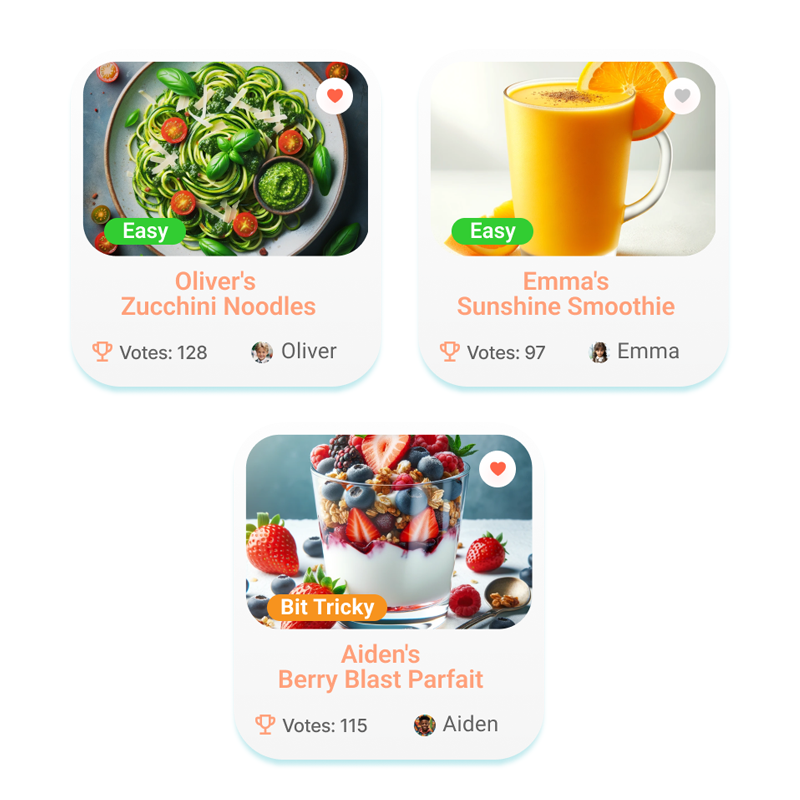
Personalized Recipe Suggestions: Tiny Chef adapts to each child’s preferences by suggesting recipes based on their tastes and past interactions. This personalized approach encourages kids to explore new recipes that align with their unique interests, making the cooking experience more engaging and tailored to their tastes.
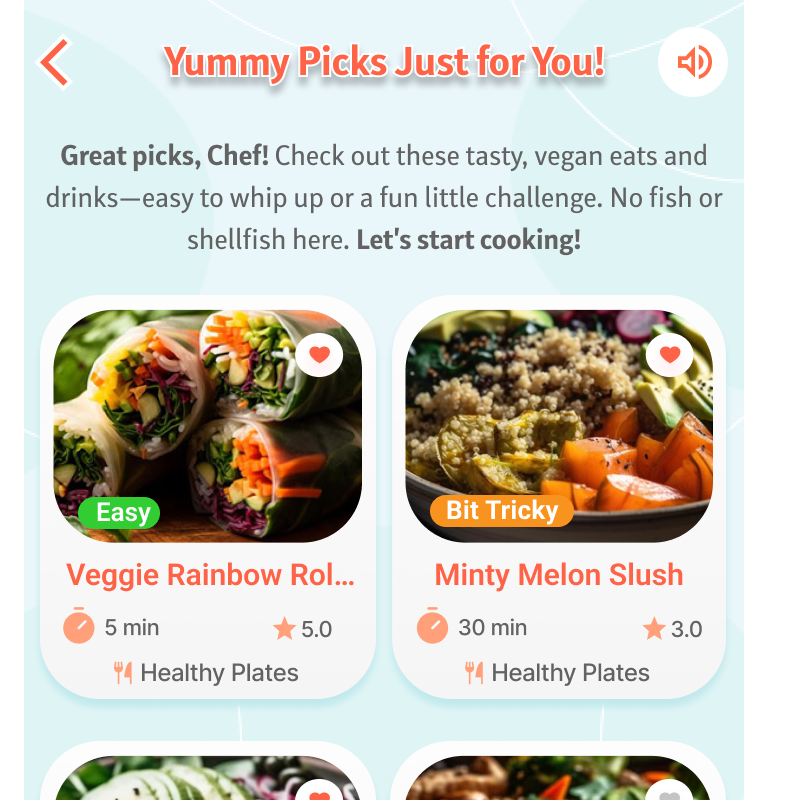
Interactive and Accessible Search with Voice Assistance: Tiny Chef’s search feature includes bold, image-based categories designed for young non-readers, making it easy to explore options visually. Each recipe challenge is color-coded—green for easy, orange for moderate, and red for advanced—to help kids choose recipes that match their skill level. The app also offers a voice assistance feature with an on/off activation, where non-readers can have recipes and instructions read aloud to them, ensuring an inclusive and accessible cooking experience for all children.
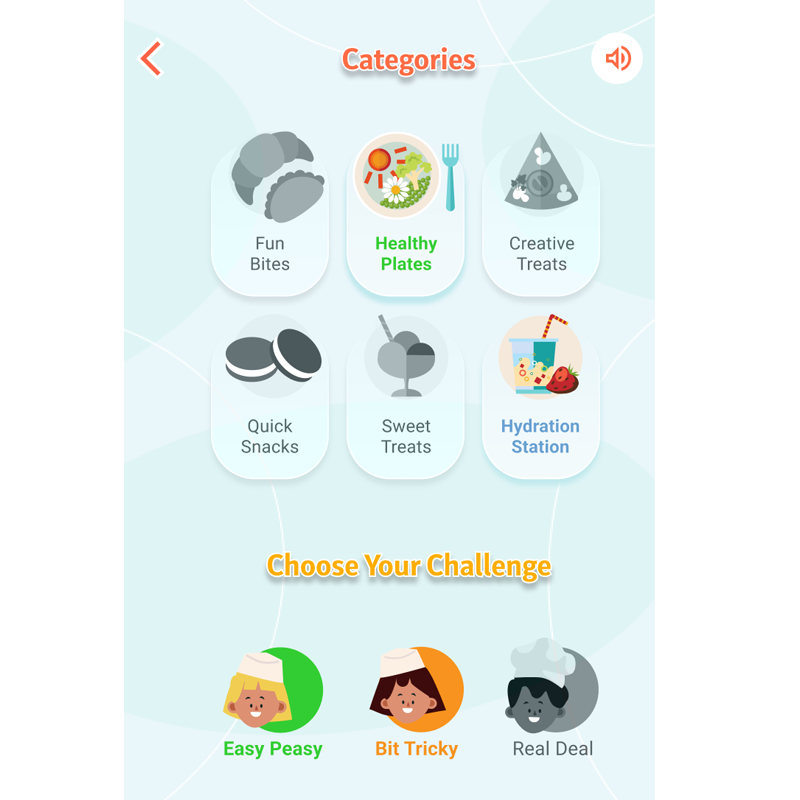
Refining the Design Process
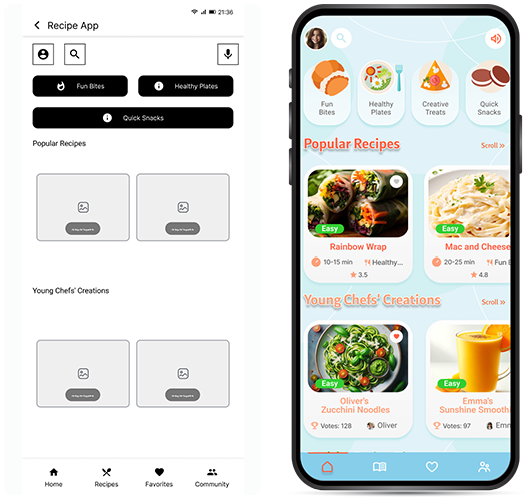
To design the Tiny Chef app, I began by researching existing cooking apps for children, focusing on their strengths and identifying areas for improvement. This analysis revealed a gap in the market for a highly engaging, educational app tailored to young, non-reading users with dietary needs and varying skill levels. These insights inspired the creation of Tiny Chef, an app designed to combine interactive learning with healthy eating for kids.
Using these findings, I created Storyboards to illustrate key user scenarios, such as young chefs navigating a visually driven cooking experience. From there, I developed a User Flow to guide kids through categories like “Fun Bites,” “Healthy Plates,” and “Sweet Treats,” allowing them to choose recipes by difficulty levels and complete cooking challenges with rewards.
I sketched Paper Wireframes to design a child-friendly layout, including large icons for recipe categories, filters for dietary preferences (e.g., Vegan, Kosher), and color-coded difficulty levels like “Easy Peasy” and “Bit Tricky.” These wireframes laid the foundation for an intuitive, playful interface that balances learning with fun.
Next, I refined the design with Digital Wireframes in Figma, adding accessibility features such as voice-activated instructions for non-readers and “Healthy Eating Tips” to encourage nutritious choices. I then created a Low-Fidelity Prototype to test navigation and ensure that kids could explore recipes and start cooking without advanced reading skills.
In the final High-Fidelity Prototype, I integrated vibrant visuals, interactive features, and a playful color scheme. Unique elements like bold image-based categories, voice assistance, and dietary customization brought the app to life. The result is a polished, engaging cooking experience designed to inspire young chefs and promote healthy eating habits in a fun and accessible way.
Polished Experience for Young Chefs in the Kitchen
The high-fidelity prototype for Tiny Chef provides a vibrant, engaging experience, specifically tailored to young users eager to learn cooking in a safe, interactive way. This prototype streamlines the user journey, making it easy for kids to explore categories like Fun Bites, Healthy Plates, and Creative Treats, select recipes based on difficulty level, and customize their preferences with dietary filters, including vegan and kosher options.
The design prioritizes accessibility and ease of use, featuring large, bold icons for navigation, a voice-assist feature for non-readers, and color-coded difficulty tags. Kids can see clear, easy-to-follow steps with video tutorials and “Healthy Eating Tips” to learn more about nutritious choices. The layout also includes fun features like voting on Young Chefs’ Creations, earning badges, and joining friendly cooking challenges, fostering a sense of accomplishment and community.
This detailed, child-friendly design ensures an enjoyable, educational experience, empowering young chefs to confidently explore the world of cooking while supporting parents with secure controls and a well-rounded, safe environment.
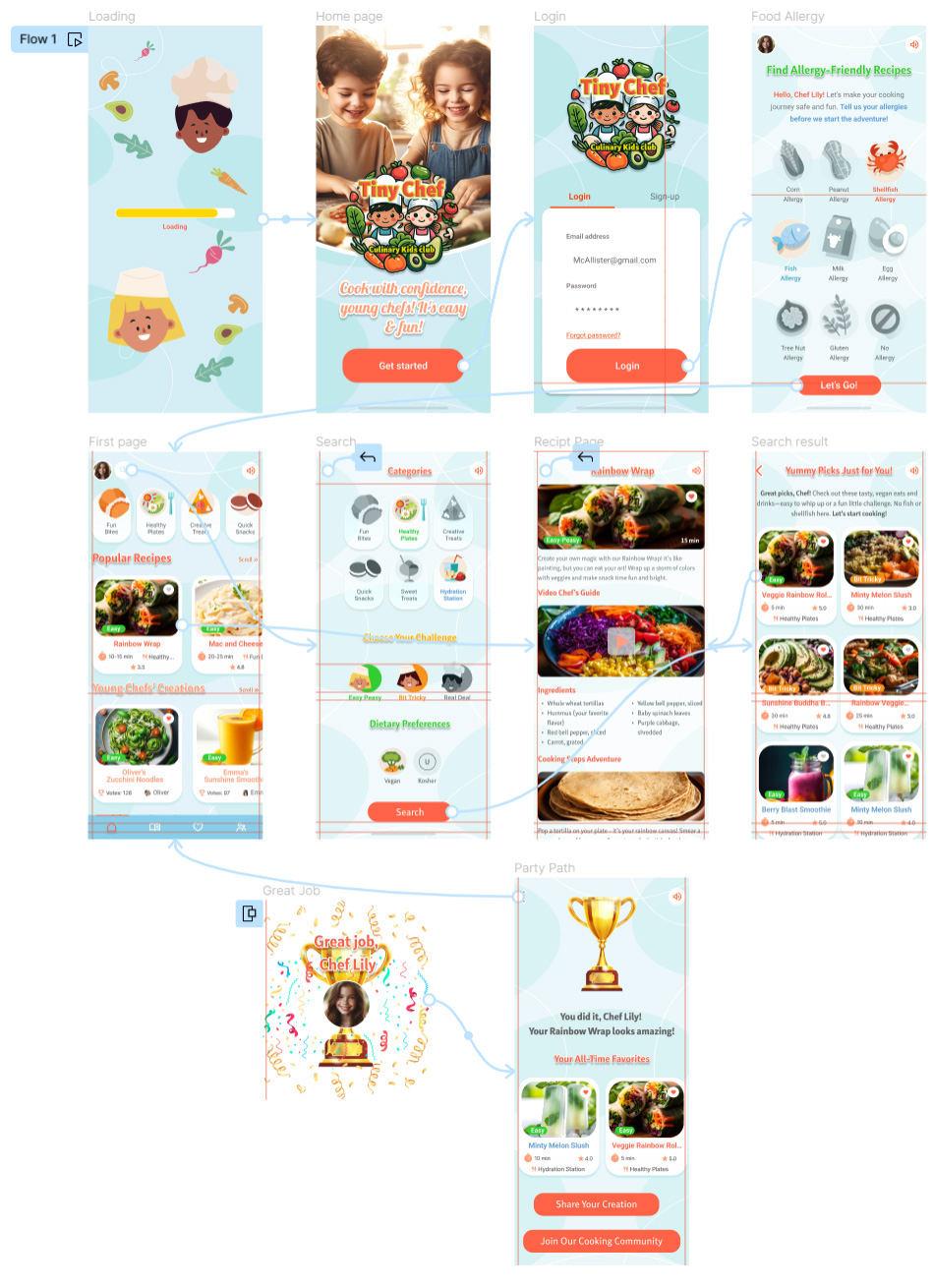
Crafting Fun and Playfulness Through Color and Design: The Visual Identity of Tiny Chef
The visual design for Tiny Chef features a lively, engaging color palette and a blend of Roboto and Submariner fonts, creating a playful yet clean aesthetic for young users. Each color and font choice has been thoughtfully selected to appeal to children’s senses, enhancing usability and making cooking exploration fun and approachable.
Vibrant Raspberry (#f2634b)
This bold, eye-catching color highlights key navigation elements and interactive buttons, drawing children’s attention to important actions and making the interface more engaging.
Sunny Yellow (#fcd804)
Used in the loader and graphical elements to add warmth and contrast, making interactive components like buttons and links stand out and feel inviting.
Sky Blue (#86cfed)
Provides a calming background that complements the brighter colors, creating a friendly and cheerful atmosphere suited for young audiences.
Fresh Green (#4db848)
Emphasizes sections related to healthy recipes and ingredients, subtly encouraging positive associations with nutritious choices and healthy eating.
Pale Sand (#f6ebdb)
A soft, neutral backdrop for background areas, ensuring readability and comfort for extended viewing without overwhelming young eyes.
Soft Azure (#5b9bd5)
Adds a gentle emphasis to certain elements without competing with primary colors, maintaining a balanced, kid-friendly environment.
This harmonious combination of colors and fonts creates an inviting, child-centered design that supports Tiny Chef’s mission of making cooking enjoyable and accessible. The visual identity is crafted to encourage young chefs to explore, learn, and create with confidence in a safe, vibrant, and visually delightful environment.
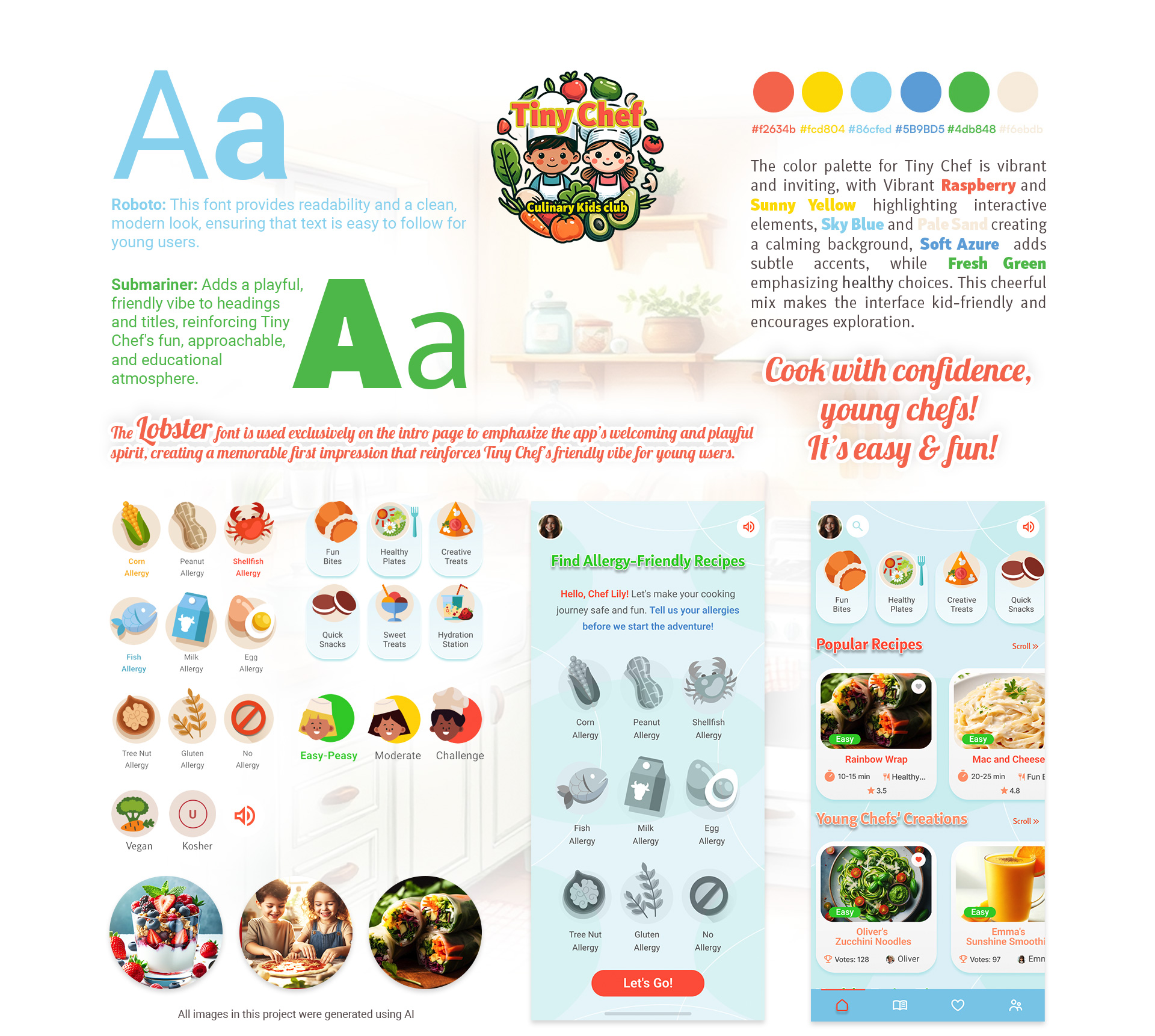
Step-by-Step User Journey: Tiny Chef App
Frame 1: Loader Screen
Displays a loading animation as the app initializes.
Key Features: Visual cue that the app is starting up.
Frame 2: Welcome Screen
Includes a “Get Started” button and a background image of a boy and girl making pizza.
Key Features: Clear display of the app logo, inviting users to begin.
Frame 3: Login Screen
Persona-specific login with the “McAllister Login Frame.”
Key Features: Allows users to enter credentials for a personalized experience
Frame 4: Allergy Selection
Allows users to select allergies or choose “No Allergy” at the top of the page.
Key Features: Personalizes content based on dietary needs.
Frame 5: Main Menu Navigation
A horizontal menu with categories like “Fun Bites,” “Healthy Plate,” and “Creative Treats.”
Key Features: Colorful icons, voice navigation for non-readers, access to popular recipes and tips.
Frame 6: Search Page
Users select categories, difficulty levels, and dietary preferences.
Key Features: Filters recipes by user preferences for a tailored experience.
Frame 7: Personalized Recipe Suggestions
Displays recipes based on user choices like dietary needs and difficulty.
Key Features: Tailored recipe suggestions, engaging visuals.
Frame 8: Recipe Details
Detailed instructions, ingredients, and a video guide.
Key Features: Step-by-step guidance, fun tips for an interactive experience.
Frame 9: Completion Confirmation
Users press “I did it!” after completing a recipe.
Key Features: Congratulatory message reinforces a sense of achievement.
Frame 10: Rewards and Community Engagement
Displays a trophy and invites users to join the community.
Key Features: Recognition, community interaction, and sharing options for young chefs.
Tiny Chef UX/UI Prototype
For the best experience, please view this prototype on a desktop. Some elements may not display optimally on smaller screens.
Takeaways from This Project
This was my first project for the Google UX Design Certificate, and I chose to explore a unique area – creating a cooking app specifically for children, an audience often overlooked in app design. Working on Tiny Chef allowed me to dive into designing for young users, emphasizing accessibility, engagement, and learning.
The experience highlighted the importance of user-centered design, especially for children who need intuitive navigation, large icons, and interactive features like voice assistance. By focusing on a vibrant color palette and playful layout, I crafted an app that feels inviting and makes cooking fun and accessible for all.
Through this project, I learned the value of balancing functionality with visual appeal and the importance of scalability, ensuring the app can grow without losing its core experience. Overall, this project taught me how thoughtful design can create a safe, delightful environment that inspires young chefs, marking an impactful start to my UX journey.